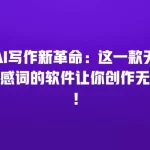共计 4211 个字符,预计需要花费 11 分钟才能阅读完成。
 “ 聊天智能免费入口大全 ”
“ 聊天智能免费入口大全 ”
Understanding the Plagiarism Rate of AI-Generated Papers: What Researchers Need to Know" />
As artificial intelligence (AI) technologies become increasingly integrated into various domains, their application in academic writing has sparked both interest and concern. Researchers and students alike have begun to explore the potential of AI tools to generate essays, research papers, and other academic content quickly and efficiently. However, a crucial question arises: What is the plagiarism rate of AI-generated papers? Understanding this issue is vital for anyone considering the use of AI in their writing endeavors, particularly in academic settings.
The Rise of AI in Academic Writing
AI writing tools, such as OpenAI’s GPT models and various other platforms, offer users the capability to create written content on a wide range of topics. These tools can generate essays, reports, and even entire research papers within minutes. While they can help save time and enhance productivity, the concern about originality and the risk of plagiarism remains high.
Academic integrity is at stake; thus, it’s essential to explore how AI tools create content and what that means for the authenticity of the work produced.
参考文章: 揭秘 mate60pro 灵动岛功能,快来了解这款手机的真实表现与使用体验!
How AI Generates Content
AI writing generators work by analyzing vast datasets of existing texts to learn patterns, context, and language structures. By utilizing machine learning algorithms, these tools can produce new text based on the stylistic and thematic elements of the training data. While AI-generated content can appear original on the surface, it can inadvertently mimic existing writings in certain contexts.
The challenge lies in ensuring that the output does not overlap too much with existing material, which could trigger plagiarism detection when checked. Understanding this process is critical in evaluating the originality of AI-generated works.
Plagiarism Detection in AI-Written Papers

参考文章: 如何利用 AI 写论文,提升写作效率和质量的最佳方法是什么?
Plagiarism detection software, such as Turnitin and Grammarly’s plagiarism checker, scans documents against extensive databases of published works to identify similarities. When using AI writing tools, it is possible for their outputs to contain phrases or structures that closely resemble those from the training data. Thus, the question arises: Is there a high plagiarism rate for AI-generated papers?
Various studies and user experiences suggest that some AI-generated content may show a significant similarity index, particularly if the prompt provided to the AI is too vague or if it draws on widely discussed topics. In fact, it has been reported that the plagiarism rate for some AI-generated essays can be substantially high, especially if proper care is not taken to edit and personalize the content after generation.
Best Practices for Using AI in Academic Writing
To mitigate the risks associated with plagiarism when using AI writing tools, consider the following best practices:
The Future of AI in Academic Writing
As AI continues to evolve, understanding the implications of using AI-generated content in academic settings will be increasingly important. Institutions are likely to develop more stringent policies regarding the use of AI in academic writing, and students must be prepared for this evolving landscape.
AI has the potential to be a powerful tool; however, it is paramount to approach its use with caution and integrity. By maintaining a focus on original thought and diligent editing when working with AI writing tools, researchers can harness the advantages of this technology while upholding academic standards.
Conclusion
In conclusion, while AI-generated content can assist in writing papers efficiently, researchers should remain vigilant about the potential for plagiarism. Understanding how these tools operate, along with adopting best practices and utilizing plagiarism detection software, will help to ensure the work produced is both effective and original. By embracing the advantages of AI while respecting academic integrity, we can pave the way for thoughtful and innovative scholarship in the digital age.







